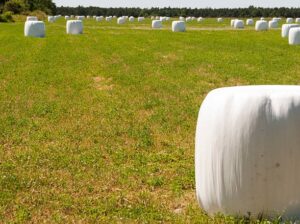Bale Wrap: Choosing Bale Wrap for Durability and Practicality
The net wrap helps protect bales from the elements to minimise spoilage and loss of forage quality. Did you know that durable bale wrap reduces handling and storage costs and improves feed safety?
Strength
Bales wrapped in plastic film can be stacked to save space, which can help farmers minimise storage and handling costs. This plastic film also protects the bale from the elements, allowing for a longer storage period without spoilage or degradation. In addition, the wrap helps preserve nutritional value and prevents odours from permeating the bales. Plastic wrap is easy to apply and can be purchased from various suppliers. This material is also environmentally friendly, making it a popular choice among farmers.
 Another benefit of using net wrap is that it prevents moisture from forming inside the bales. It is a significant concern for producers who bale wet hay. Moisture in a bale can cause mould growth and reduce the forage quality. Additionally, this moisture can create a layer of decomposed hay on the outside of the bale. It can affect the flavour and quality of the hay and decrease livestock intake.
Another benefit of using net wrap is that it prevents moisture from forming inside the bales. It is a significant concern for producers who bale wet hay. Moisture in a bale can cause mould growth and reduce the forage quality. Additionally, this moisture can create a layer of decomposed hay on the outside of the bale. It can affect the flavour and quality of the hay and decrease livestock intake.
A net wrap is a specialised plastic film that can keep bales of wet or dry hay from moulding and improve their nutritional value. It is typically made of high-density polyethylene particles, with UV stabilisers added to improve outdoor stability. This type of wrap is designed to be durable and withstand weather conditions, and it can be applied quickly by a round baler.
Durability
When appropriately used, durable bale wrap minimises bale loss and waste, improving the overall value of your hay. It protects the bale from moisture and other elements that can cause spoilage while reducing physical losses during transportation and storage. It is important to use the right number of layers and proper wrapping techniques to ensure success. A table in the operator’s manual can help determine the appropriate layer count for your bale size and moisture level.
Using net wrap also helps you save time and money. It allows you to create more round bales in the same time as a conventional baler. Moreover, it is available in several different sizes to meet your needs. It is recommended that you use a larger size for higher-moisture bales.
Ease of handling
While it can be time-consuming to wrap large round bales individually, ensuring that the wrap remains intact is worth the effort. It helps the hay retain its nutritional value and allows dairy farmers and beef producers to sort bales based on quality, improving cattle or horses’ feeding efficiency. The wrap also reduces field losses and saves farmers the expense of building a silo or bunk-type storage facility.
When wrapping hay, the most important thing is to keep air out. A bale will leak and spoil if it is not wrapped tightly enough. The number of wraps required depends on moisture levels and the type of hay being baled. The drier the hay, the more layers of plastic wrap are needed to prevent air penetration. In addition, drier hay has sharp stems that may poke through thin plastic wrap layers.
A good rule of thumb is using two puncture-resistant film layers per bale. It is sufficient to protect hay from spoilage and will keep the feed in good condition for a long time. However, some farmers prefer to use more layers, up to six.
After a bale is wrapped, it should be stored away from trees and other objects that can cause rodent damage. Periodically check the wrap and make repairs as necessary. Don’t move or handle the wrapped bales after 12 hours; doing so can expose them to oxygen and restart aerobic deterioration.
Ease of storage
A good way to prevent moisture from spoiling hay is by wrapping it. The plastic wrap keeps the hay dry, reducing the amount of water loss that can cause rotting and mould growth. It can also help protect the hay from damage during transport and storage.
In addition, it can reduce the time it takes to bale hay by allowing the farmer to make more bales per hour. Compared to twine, net wrap only requires a few turns of the baler, and it can save up to 30% in labour costs. It is important because it can lead to significant financial savings for the farm.
The type of durable bale wrap farmers choose depends on the per cent moisture at the time of baling. The drier the hay, the more layers of plastic wrap are needed. It is because drier hay has sharper stems that can poke through the wrap if there aren’t enough layers. Stacking wrapped bales on washed gravel helps prevent leaks by creating a path for rainwater. It also helps to keep rodents away from the bales.
You May Also Like
